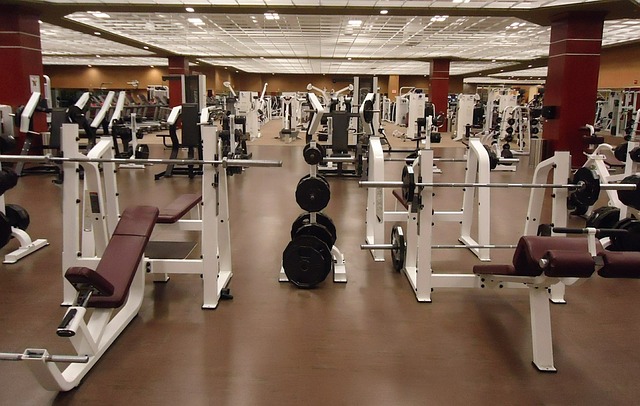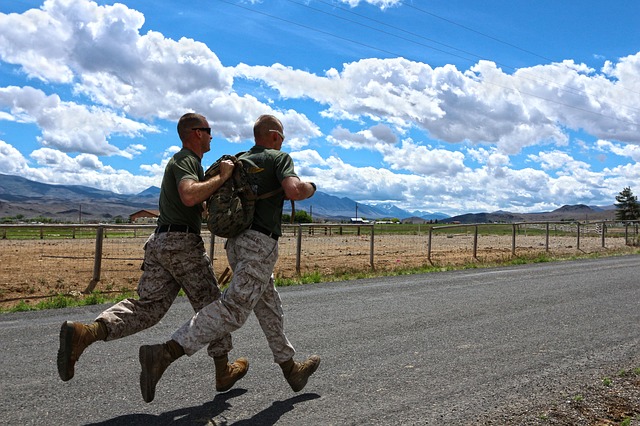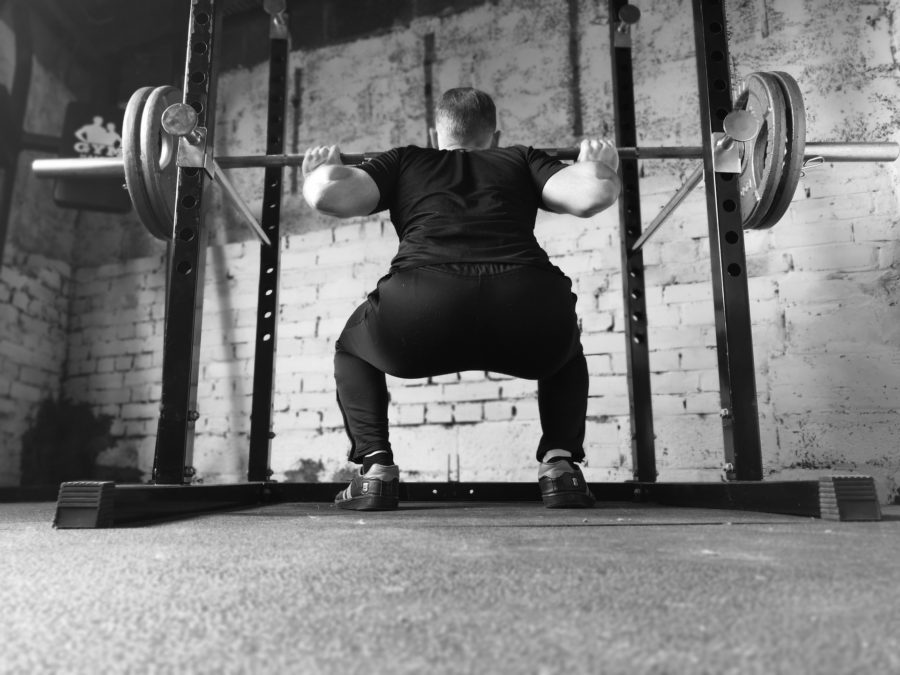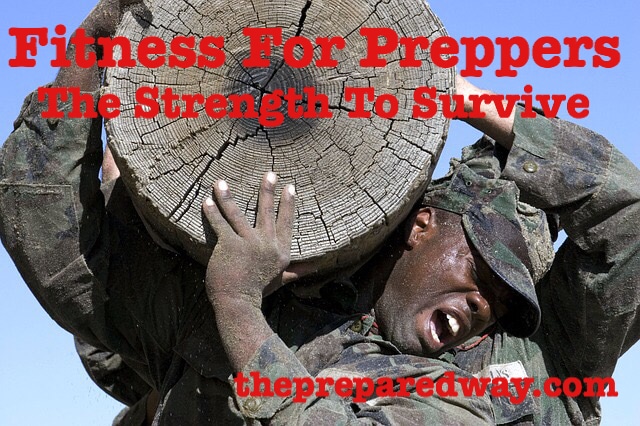What level of fitness does someone need to be prepared for SHTF, bugging out, a grid down situation, off-grid living or other emergencies? The answer is easy, a survival level of fitness.
What is a survival level of fitness? It’s being able to perform a variety of Strenuous physical activities, on demand, without injury; i.e. Lifting and carrying heavy objects, hiking for miles with a heavy pack, carrying water, chopping and carrying wood, hunting, and tracking game, etc.
If there is one thing in the preparedness community that is overlooked most often it’s physical health. You will often see “preppers” that are overweight, drinking, smoking and making very poor nutritional choices right now but are preparing to survive long term SHTF. Why prepare to survive long term grid down when you are making decisions now that will almost guarantee complications from heart disease, cancer, or other diseases?
Stronger people are harder to kill, a saying that floats around in circles of people “in the know”. People that understand basic biology, know that that stronger you are the more likely you will be able to survive not only a physical emergency or physical attack but also an illness. More strength will lead to more dense muscle mass which means more strength during a severe illness and more strength during recovery.
Strength & Endurance
There are many different types of fitness, some will even say there are many areas of fitness like; strength, endurance, stamina, flexibility, agility, balance, coordination, power, and speed that all need to be addressed and yes that is true but it over complicates things. You can take all of the different aspects of physical fitness and boil them down into two things Strength and Endurance.
At the extremes, you have long distance endurance runners like marathoners and strength athletes like powerlifters. These are very focused disciplines that are not the most ideal for our end goal. Where should we be on the scale between strength and endurance? The answer is, somewhere in the middle.
As with most things, when it comes to preparedness, you want to be well rounded. I doubt there will be a time when you would need to run 20+ miles flat out, to do so without support would be a terrible idea but you might need to cover 3 to 6 miles in a hurry. When it comes to strength, you can never be too strong but you don’t what to be too big and bulky either.
One thing you need to understand is that strength and size are not necessarily in direct correlation. It’s really about muscle fiber recruitment. It is true that larger muscles have more fibers to recruit and do have the potential to be stronger if properly trained.
Be Well Rounded
There is an entire fitness industry pushing the latest and greatest equipment, techniques, and supplements, it does make it difficult for some people to know what’s, what.
So where do you start? For a well-rounded fitness approach, there are 3 areas that need focus, Nutrition, Strength Training, and Cardiovascular endurance.
A QUICK NOTE: Before starting any exercise program, check with your doctor to ensure that you do not have any underlying conditions that may be adversely affected by different forms of exercise.
Set Goals
In order to get where you want to be, you need to first know where you are right now and where you want to go. Unforurently, I will be unable to help you with this part. Only you know what your current physical condition is and what your overall goals are.

Do you know the difference between exercise and training? Exercise is someone just going through the motions. If you go to the gym you will see many of these people. They walk in and go to the treadmill walk or lightly jog on it for 20-30 minutes hop off and then go hit some of the machines for another 20 minutes then call it quits for the day and there’s nothing wrong with that. At least they are doing something but training is different.
Training is about having a clearly defined plan every time you walk into the gym or head out for a run. Each workout is planned ahead of time, long before you ever step into the gym. You need to have daily, weekly, and monthly goals, these will pave the way to your primary goal. With each workout, you will be adding more weight or more distance or more speed, that is with one exception, recovery days of course.
What are some of the things you may need to do if things go sideways? It may be different for everyone. Maybe your bug out location is 20 miles away, can you hike 20 miles with your bug out bag? Maybe your primary water source is one mile away, can you carry two 5-gallon jugs of water for a mile? If you can do these things now you will be much better off then you need to do them to survive.
Fitness Standards
Having goals is great but to keep yourself honest you should decide now what your minimum standards and your preferred standards will be. A good place to start is with the military standards. The military has spent many years developing their fitness standards so it’s a great starting point.

What I would not do is use the basic Physical Fitness Test (PFT) as your overall goal but as a stepping stone to more challenging standards like the PFT for special operations selection (i.e. SEAL/BUDS, MARSOC, Green Beret) Being able to achieve these standards should leave no doubt that you have achieved a survival level of fitness. Achieving these standards will not be easy, more importantly, achieving these standards without injury should be your top priority.
Getting Started
Some people get really excited about starting a new fitness program and go all in and completely change their diet and start strength training 3 days a week and start running 3 days a week but what often happens, this is too much of a change from their normal routine and they easily become overwhelmed. The key to success is to make small changes to your routine over time using a progressive stair-stepping process.
You have to look at it as a marathon, not a sprint. It’s best to make small changes to your habits for long-term success. Maybe you start with your diet and cut out surgery drinks and stop getting seconds at dinner this week, then next week you start strength training two days a week. Then after a few weeks, you add another day of strength training so your lifting three days a week.
After you get settled in lifting three days a week and you have comfortably integrated lifting into your weekly routine then it’s time to add one or two days of cardio and do your routine. Then maybe add a third day down the road, when you feel like you are ready.
The speed of your progression through the different phases of your training will depend a lot on where you are starting from and your age. These two factors will dictate many parts of your training regiment. If you are older than forty or are overweight you will have more obstacles to overcome than those who are not. Also, if you are near or past your forties you will also have more obstacles to contend with.
Food = Fuel
One of the first places to start is with your diet. When you start training you have to remember that the food you eat is what your body uses for fuel. I’m a car guy so it’s easy for me to use is analogy; Your body is an engine and the food you eat is its fuel. If you want a race engine to perform at peak efficiency you can’t use regular pump gas, you need high octane race gas, right? Even the best engine can’t run at its peak efficiency on low-quality fuel.
Your body is the same, if you fill your tank with substandard fuel your performance will suffer. That’s why I think the first step to a survival level of fitness starts with what you put in your mouth. Ever hear the saying, you are what you eat? The saying implies that if you eat junk food then your body will respond accordingly and if you eat healthy foods the opposite will be true.
The 80/20 Rule
If you have never heard of the 80/20 rule as it applies to diet? This is a great rule when it comes to how you approach what you eat. It goes like this; 80% of the time you stick to a predetermined meal plan. I call it a meal plan and not a diet because this is not a temporary thing, it for living and being healthy in the long run. That means 8 out of 10 meals or 8 out of 10 days need to be healthy choices. The other 20% of the time you eat whatever you want. Just remember this is not an all you can eat buffet for three straight meals, you must still exercise some restraint but you can eat those foods that are otherwise not on your daily meal plan.
What to Eat
This is the easy part, you need to eat non-processed foods. Stick to the basics; meats, fruits, vegetables, beans, and unprocessed grains like oats. If you must have your bread it’s best to stick with whole grain/whole wheat bread. Each meal should include a mix of Protein, Carbohydrates, and Fat.

I’m not going to break down how much protein, carbs, and fat you may need, only dedicated athletes need to track their macronutrients down to the specific gram. All we need to do is divide our plate into two, the one half will be protein i.e. meats like chicken, beef, pork, and fish. The other half will be divided again and will have complex carbs like rice or sweet potatoes and vegetables like green beans, broccoli, carrots, cauliflower, etc.
This way of eating takes some time to adjust to but remember if you are craving pizza or a Philly Cheeze Steak sandwich, two out of ten meals you can have that stuff and still keep moving in a healthy direction.
Strength Training
In the hierarchy of prepper fitness, strength training ranks at the top. What does this mean? If you only have time in your schedule for strength training or running, go with the strength training. Many people work somewhat sedentary jobs these days and unless you are a farmer, in construction or some similar type of job you don’t get the daily physical strain on your body like previous generations.
Training for strength may be hard but it doesn’t have to be complicated. The key is to focus on the primary strength building exercises.
- Squat
- Deadlift
- Power Clean
- Bench Press
- Shoulder Press
- Pull-up/Chin-up
With these 6 movements, done properly, you will stress every major muscle in the body.
I’ve been strength training on and off for over 25 years. I’ve tried many different systems and routines and all of them worked okay but after several injuries over the years, I discovered a system that is by far the best for building a concrete foundation without the risk of injury, the Starting Strength model.
The Starting Strength Model
The Starting Strength program is very basic but very effective. All you need is a gym that has a pull-up bar, squat rack, flat bench, and an Olympic barbell with plates. Beyond that, no special equipment or machines are needed.

Using linear progression, the Starting Strength plan starts your lifts well below your maximum potential and slowly adds a little weight to each lift, every workout session. This slow progression allows the lifter to become familiar with their body and their body to become familiar with the lifts. This is important for reducing the risk of injury.
How To Get Started
To get started with the Starting Strength program the first thing you need to do is get their book Starting Strength: Basic Barbell Training by Mark Rippetoe <<< Click here to check it out on Amazon. This book goes into great detail about how each lift is performed and why. He also includes novice programming which will get most people six to twelve months, then you will be transitioning to intermediate programming.
The next thing you should do is check to see if you’re lucky enough to have a Starting Strength affiliate gym in your area. If not, check to see if they are doing any Starting Strength seminars in your area.
For intermediate and advanced programming check out Practical Programming for Strenght Training by Mark Rippetoe and Andy Baker <<< Click here to check it out on Amazon
Those over the age of forty, check out The Barbell Prescription: Strength Training for Life After 40 by Jonathon Sullivan and Andy Baker. This book covers the physiological changes that occur as we age and how to adapt your training to maximize your strength gains while reducing the risk of injuries. With novice, intermediate, and advanced programming based on the Starting Strength model for those near forty to those over seventy!
Running/Cardio
Running has benefits beyond getting from point A to point B quickly by foot. Cardio improves overall heart health and improves the heart and lungs ability to get oxygen to muscles. When it comes to cardio/conditioning there are two basic types of training, Long Slow Distance (LSD) and High-Intensity Interval Training (HIIT), as preppers, we want to work on both.
As I said before the likelihood of needing to run more than 6 miles is unlikely, you would more than likely be hiking with a pack beyond that distance but for overall conditioning and general fitness being able to run 30 minutes at a 9-minute mile 2-3 days, a week would be a good goal.
Goals
When it comes to running I find that to stay motivated I need to have well-defined goals. What I have found that works best for me is to run local 5k races occasionally. Training for a 5k race offers a great goal and great motivation. Training for a 5k incorporates both HIIT and LSD training.

5k Training
My 5k training is based on training 3 days a week. I start the week with an “easy” day, this day is 30 minutes at a pace that is about 1 minute slower than my 5k races pace, followed by a rest day. Day two is either interval training or hills training followed by two days of rest. The last day is a long run day usually 6 to 7 miles at a pace that is about 2 minutes slower than my 5k race pace, followed by a rest day. Then rinse and repeat.
Day 1: Easy Day
The easy day is as it sounds, an easy day when compared to the other two workouts. There are really two objectives during this workout. The first is to continue to build a solid cardio base. The second objective is learning how to control your pace.
Day 2: Interval/Hill Training
When done correctly day 2 will kick your ass! Day two’s objective is to increase your speed. To increase your speed you need to improve your heart and lungs ability to get oxygen to your muscles and to increase strength. We’ll start by discussing interval training.
Interval Training – In classical running terms interval training uses distances i.e. 400m, 800m, etc. For those who run on a track that works fine but for the rest of us even with modern GPS watches doing intervals by distance can be difficult. That is why I use timed intervals instead. Using timed intervals allow you to use any watch with a timer or even your phone. For 5k training, I stick with (8) – 1-minute intervals, (6) – 2-minute intervals, and 1-2-3 intervals. I picked up this particular method a few years ago from an article by runnersworld.com <<< check it out here. They do an excellent job explaining how to perform the intervals from proper warm up to cool down, which is beyond the scope of this article. To keep things simple I just use the basic interval part of the article.
Day 3: Long Run
Even if you are only training for a 5k (3.1 miles) you still need to build some endurance. To maximize the endurance needed to post an excellent 5k time you need to be able to run nearly double that distance at a pace that is about 2 minutes slower per mile than your race pace, that means 6+ miles.
Functional Fitness
Functional Fitness is a method of working out that uses exercise techniques applied in a way to simulate real-world applications. Normally, as an athlete, you would work on your strength training and cardio, then do your sport or activity to perfect those specific movement patterns. Just like a pro football player will hit the gym on certain days and practice on the field other days.
Performing that sport or activity allows your body to adapt to stresses that are different than your lifting and cardio routines. The problem is that as preppers we do not have a specific sport that we train in. To truly be ready for anything we must train for a variety of situations.
Parting Thoughts
There are many facets to physical fitness and numerous points of view. Everyone is different and what works for one person may not work for another. The key is to do what you can to make yourself better every day. Small changes add up over time and with the right motivation, you can achieve your prepper fitness goals.


